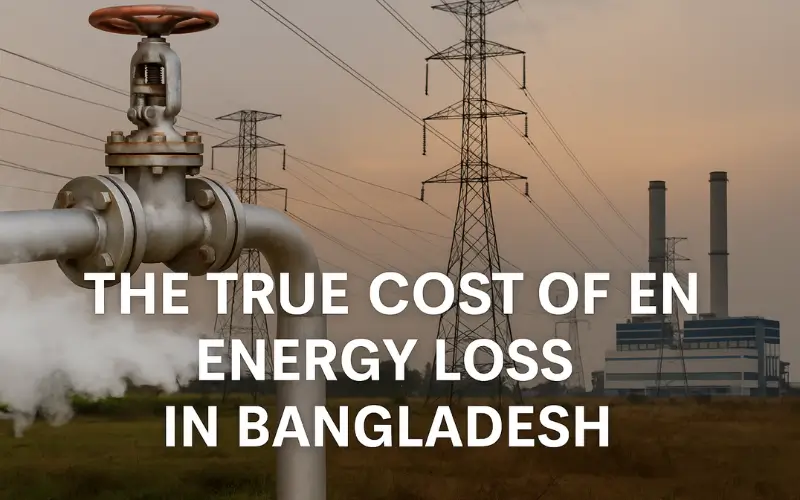Every year, Bangladesh silently bleeds billions of Taka due to one of the least visible yet most damaging economic drains—energy loss. Whether it’s gas leaking through aging pipelines, electricity vanishing in inefficient transmission lines, or idle power plants racking up capacity payments, the nation’s energy sector suffers from inefficiencies that cost far more than most realize.
According to recent reports, system losses in the gas sector alone can exceed Tk 3,500 crore annually, while distortions in the power sector cost the economy over Tk 93,000 crore—nearly 5% of the GDP. These aren’t just numbers in an annual report; they represent higher tariffs for consumers, greater subsidy burdens for the government, and missed opportunities for industries to thrive.
In this article, we’ll break down the true cost of doing nothing—exploring where and how Bangladesh is losing energy, why it matters, and what steps can save both money and resources. By understanding the scale and nature of these losses, we can better see why urgent action is not just an economic choice, but a national priority.
Current Scale of Energy Losses in Bangladesh
Gas Sector System Losses
- Fiscal Year 2023–24 saw average gas system losses of 6.28%, translating to nearly Tk 3,790 crore in losses
- In contrast, Titas Gas reported a system loss rate of 10.13% during July–March FY24—well above the international standard of 2%
- These inflated system losses forced Titas Gas into a net loss of Tk 711 crore in the first half of FY 2024–25 (July–December), driven by the gas leakage costs and shifts in tax liabilities
Energy Cost from Underpriced Natural Gas
The underpricing of domestic natural gas imposes an additional economic burden equal to 3.63% of GDP, reflecting inefficient utilization and broader macroeconomic costs
Power Sector Distortions & Transmission Losses
- Though a specific Bangladesh-only figure is scarce, a World Bank report for South Asia finds distortions in the power sector cost economies between 4–7% of GDP annually
- According to IEEFA, the Bangladesh Power Development Board (BPDB) has absorbed a cumulative subsidy of Tk 1,267 billion from FY 2019–20 to FY 2023–24, with a revenue shortfall of Tk 236 billion over the same period
- Transmission and distribution (T&D) losses remain high—around 10.33%, compared to the global average of under 8%
Industrial Output Loss from Power Interruptions
Though data is dated (2000–01), industrial supply interruptions caused losses equivalent to approximately 1.72% of GDP—reflecting severe production disruptions
Summary Box
| Domain | Key Metric | Financial Impact |
| Gas Sector Losses | 6.28–10.13% system loss | Tk 3,790 crore (FY 23–24); Tk 711 crore loss (H1 FY25) |
| Underpriced Gas | 3.63% of GDP | Broad economic inefficiency from below-cost pricing |
| Power Sector Distortions | 4–7% of GDP (regional benchmark) | Indirect losses across economy due to inefficiency |
| BPDB Subsidies & Losses | Tk 1,267 billion (FY19–24); Tk 236 billion loss | Fiscal burden from under-recovery and inefficiencies |
| T&D Losses | 10.33% | Higher energy wastage and financial leakages |
| Industrial Interruptions | 1.72% of GDP (historical data) | Output disruptions due to unreliable supply |
Causes of Energy Losses
Energy losses in Bangladesh stem from a mix of technical failures, non-technical theft and billing issues, and structural inefficiencies in planning and governance. Understanding these root causes is crucial to designing effective solutions.
Technical Losses
These are losses that occur naturally in the process of producing, transmitting, and distributing energy due to limitations in technology and infrastructure.
Transmission & Distribution Inefficiencies
- Copper & I²R Losses: Electrical resistance in transmission lines and transformers causes heat dissipation and energy wastage.
- Aged Infrastructure: Many power lines, transformers, and substations are beyond their intended service life, increasing energy leakage.
- Overloaded Lines: In peak demand periods, overloading increases resistive losses.
Gas System Technical Wastage
- Pipeline Leaks: Cracks, corrosion, and poor maintenance in gas pipelines allow significant leakage.
- Pressure Drops: Poorly calibrated valves and compressors reduce delivery efficiency.
- Obsolete Measurement Systems: Manual metering results in inaccurate readings and unaccounted gas loss.
Inefficient Generation Units
- Old Thermal Plants: Low thermal efficiency leads to higher fuel use per unit of electricity generated.
- Unoptimized Dispatch: Plants are sometimes run below optimal load, wasting fuel and lowering efficiency.
Non-Technical Losses
These are preventable losses that result from human actions—either deliberate or due to negligence.
Theft & Illegal Connections
- Widespread electricity and gas theft via bypassed meters or unauthorized lines.
- In some areas, “system loss” statistics hide theft figures to reduce reported crime rates.
Billing & Meter Tampering
- Manipulated meters to under-report usage.
- False billing entries or non-billing of certain large consumers.
Collection Inefficiency
- Utilities sometimes fail to collect payments from state-owned enterprises or politically connected consumers, creating a financial black hole.
Overcapacity & Idle Capacity Charges
- Bangladesh’s installed generation capacity often exceeds peak demand by 40–50%, leading to high capacity payments for idle plants.
- Even when plants are not producing electricity, contractual obligations force the government to pay private producers.
- This idle cost inflates electricity tariffs and subsidies.
Subsidy & Tariff Distortions
- Artificially low tariffs for gas and electricity encourage overconsumption and discourage efficiency investments.
- Subsidies eat up a large share of the national budget, reducing funds available for infrastructure upgrades.
- Cross-subsidies between sectors can result in uneven financial stress on industries and households.
Regulatory & Governance Gaps
- Weak Enforcement: Theft, tampering, and non-payment often go unpunished.
- Slow Modernization: Delays in rolling out smart meters, SCADA, and leak detection systems.
- Political Interference: Decision-making skewed towards short-term populism rather than long-term efficiency.
Economic & Social Impacts (Costs)
When energy is lost, the cost is far more than just a number on a utility balance sheet—it ripples through government budgets, industrial output, household expenses, and national economic growth.
Direct Fiscal Costs
Subsidy Burden
- The Bangladesh Power Development Board (BPDB) received Tk 1,267 billion in subsidies between FY 2019–20 and FY 2023–24 to cover revenue shortfalls caused by inefficiencies and overcapacity.
- In FY 2023–24 alone, subsidies reached Tk 382.89 billion, a massive strain on public finances.
Gas Wastage Losses
- System losses in gas distribution cost Tk 3,500–4,000 crore annually.
- These losses directly raise the cost of imported LNG, as more fuel is purchased to compensate for wastage.
Lost Economic Output
Industrial Downtime
- Electricity supply interruptions can cause losses equivalent to 1.72% of GDP annually, especially in export-driven sectors like textiles and garments.
- Production halts lead to missed export deadlines, penalties, and reduced competitiveness.
Reduced Energy Security
- High system losses force greater reliance on expensive fuel imports, exposing Bangladesh to global price volatility.
Opportunity Costs
- Money spent on subsidies and capacity payments could be invested in renewable energy, infrastructure upgrades, and public services.
- Every 1% drop in transmission and distribution losses could save Tk 12.38 billion annually—enough to build hundreds of schools or hospitals.
Social Impacts
Higher Consumer Prices
- Inefficiencies are ultimately passed to consumers through tariff hikes, making electricity and gas less affordable for low-income households.
Environmental Cost
- More fuel is burned to compensate for losses, increasing greenhouse gas emissions and air pollution.
Erosion of Public Trust
- Perceived mismanagement, energy theft, and waste can undermine public confidence in utility providers and the government.
Macroeconomic Drag
- Energy sector distortions are estimated to cost South Asian economies between 4–7% of GDP annually—Bangladesh’s share likely at the higher end due to high loss rates and overcapacity.
- Chronic inefficiency discourages foreign investment in the energy sector, as investors anticipate regulatory instability and low returns.
Solutions & Potential Savings
If Bangladesh acts decisively, it can reduce energy losses by several percentage points within a few years — saving tens of billions of Taka annually while strengthening energy security and lowering emissions. Solutions fall into technical, regulatory, operational, and behavioral reforms.
Technical Improvements
Grid Modernization
- Upgrade Transmission Lines & Transformers: Replace old conductors with high-efficiency materials; upgrade aging transformers to reduce copper (I²R) losses.
- Smart Grid Deployment: Implement SCADA (Supervisory Control and Data Acquisition) for real-time monitoring and faster fault detection.
- Reactive Power Management: Use capacitor banks to improve power factor and reduce transmission losses.
Gas Pipeline Upgrades
- Leak Detection Systems: Use acoustic sensors and drones to identify and fix leaks quickly.
- Pipeline Replacement: Swap corroded or undersized pipelines with modern coated steel or composite pipes.
- Automated Pressure Control: Prevent wastage from over-pressurization.
Regulatory & Governance Reforms
Strengthen Enforcement Against Theft
- Establish fast-track energy theft tribunals.
- Increase penalties and publicize crackdowns to deter illegal connections.
Tariff Restructuring
- Align tariffs with actual supply costs while protecting low-income households with targeted subsidies.
- Remove cross-subsidies that distort industrial competitiveness.
Independent Oversight
- Create an independent energy efficiency commission to audit utilities, monitor progress, and enforce loss-reduction targets.
Operational Optimization
Reduce Overcapacity
- Phase out expensive idle plants; renegotiate capacity payment contracts.
- Use demand forecasting tools to better match generation capacity with actual demand.
Preventive Maintenance
- Schedule regular inspections of generation units, transformers, and pipelines to prevent unplanned outages and leakage.
Combat Non-Technical Losses
- Smart Meters & Prepaid Systems: Ensure accurate billing and reduce scope for tampering.
- Automated Meter Reading (AMR): Eliminates manual errors and detects unusual consumption patterns.
Promote Energy Efficiency & Renewables
Industrial Efficiency Programs
- Provide incentives for factories to adopt energy-efficient motors, boilers, and lighting.
- Mandate energy audits for large industrial consumers.
Distributed Solar Power
- Accelerate rooftop solar installations on government and commercial buildings to reduce T&D loads and reliance on fossil fuels.
Potential Savings Estimate
- T&D Loss Reduction: Cutting from 10.33% to 8% could save ~Tk 24–30 billion/year.
- Gas Loss Reduction: Bringing losses down to the global benchmark of 2% could save Tk 2,000–2,500 crore/year.
- Overcapacity Reduction: Renegotiating idle plant contracts could save Tk 5,000–6,000 crore/year.
Total Potential Savings: Tk 35,000–40,000 crore/year — funds that could be redirected to infrastructure, education, and health.
Conclusion – Time to Act
Every kilowatt-hour lost in transmission lines, every cubic meter of gas leaking into the air, and every idle power plant quietly charging capacity payments is money slipping through Bangladesh’s fingers — money that could build roads, schools, and hospitals.
The numbers are staggering: up to Tk 40,000 crore a year wasted. This isn’t just an engineering problem; it’s an economic, environmental, and social issue rolled into one. The longer the country waits, the more expensive the problem becomes — both in financial and opportunity costs.
But the solution is clear. By upgrading infrastructure, enforcing regulations, investing in efficiency, and making smart policy choices, Bangladesh can slash losses, stabilize energy prices, and boost competitiveness.
Doing nothing is not neutral — it’s a costly choice. The true cost of inaction isn’t just measured in Taka, but in the lost opportunities for growth, jobs, and a sustainable future.
FAQs – Energy Loss Cost
1. What is energy loss cost?
Energy loss cost refers to the financial value of wasted energy during generation, transmission, or consumption. It includes technical losses (like line resistance) and non-technical losses (like theft or meter tampering).
2. How much does Bangladesh lose to energy inefficiency each year?
Estimates vary, but combined losses from electricity, gas, and inefficiency can reach Tk 30,000–40,000 crore annually.
3. What are the main causes of energy losses in Bangladesh?
Key causes include outdated transmission lines, poor maintenance, inefficient appliances, fuel leakages, and illegal connections.
4. How can energy losses be reduced?
Upgrading infrastructure, enforcing strict anti-theft laws, investing in energy-efficient appliances, and adopting smart grid technology are major solutions.
5. Who bears the cost of energy losses?
Ultimately, consumers and taxpayers bear the cost through higher tariffs, subsidies, and reduced economic competitiveness.
6. Is reducing energy losses expensive?
While upfront investment can be high, the long-term savings from reduced fuel imports, lower subsidies, and increased reliability far outweigh the costs.
7. Can households help reduce energy loss costs?
Yes — by using energy-efficient devices, maintaining appliances, reducing wastage, and reporting illegal connections, households contribute to the overall reduction.




